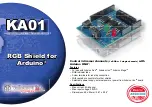other devices nearby. Studying EMC for your system allows testing the ability of your system to operate successfully counteracting
the effects of unplanned electromagnetic disturbances coming from the devices and systems around it. The electromagnetic noise
or disturbances travels via two media: Conduction and Radiation.
Figure 14. Electromagnetic noise propagation
The design considerations narrow down to:
• The radiated & conducted EMI from the board should be lower than the allowed levels by the standards you are following.
• The ability of the board to operate successfully counteracting the radiated & conducted electromagnetic energy (EMC)
from other systems around it.
The EMI sources for a system consists of several components such as PCB, connectors, cables and so on. The PCB plays a
major role in radiating the high frequency noise. At higher frequencies and fast-switching currents and voltages, the PCB traces
become effective antennas radiating electromagnetic energy; e.g., a large loop of signal and corresponding ground. The five
main sources of radiation are: digital signals propagating on traces, current return loop areas, inadequate power supply filtering
or decoupling, transmission line effects, and lack of power and ground planes. Fast switching clocks, external buses and PWM
signals are used as control outputs and in switching power supplies. The power supply is another major contributor to EMI. RF
signals can propagate from one section of the board to another building up EMI. Switching power supplies radiate the energy which
can fail the EMI test. This is a huge subject and there are many books, articles and white papers detailing the theory behind it and
the design criteria to combat its effects.
Every board or system is different as far as EMI/EMC and ESD issues are concerned, requiring its own solution.
However, the common guidelines to reduce an unwanted generation of electromagnetic energy are as shown below:
• Ensure that the power supply is rated for the application and optimized with decoupling capacitors.
NXP Semiconductors
Recommendations
Hardware Design Guidelines for LPC55(S)xx Microcontrollers, Rev. 0, 30 October 2020
Application Note
21 / 24


















